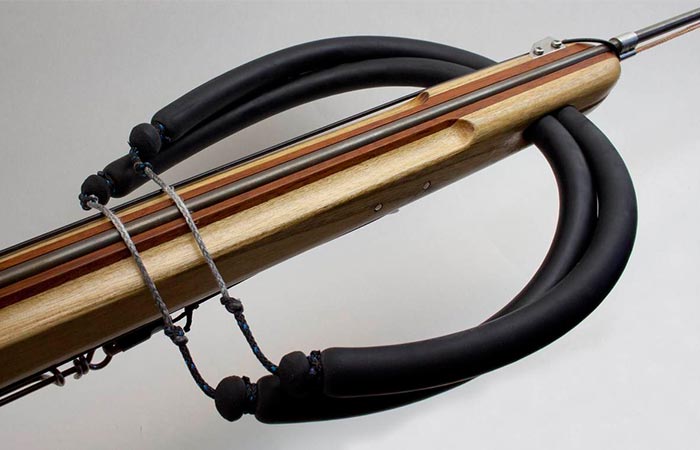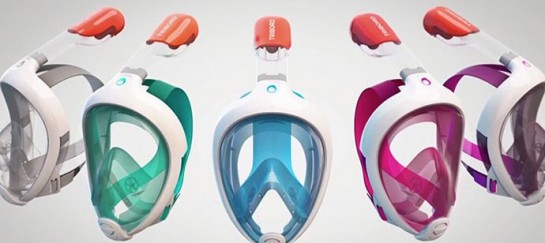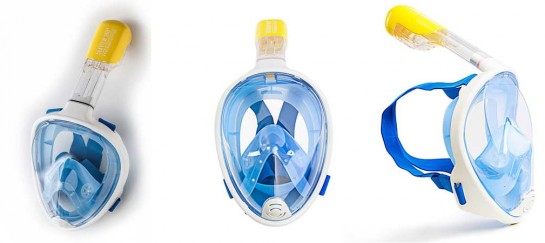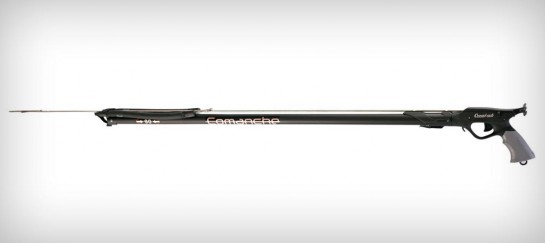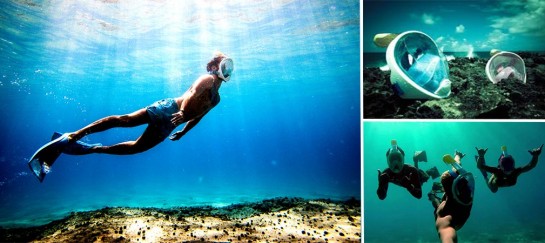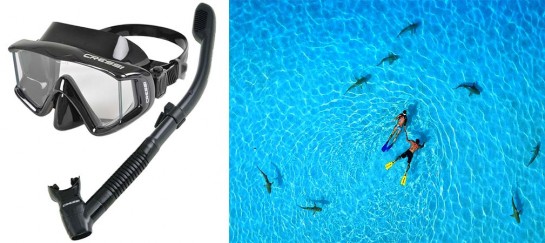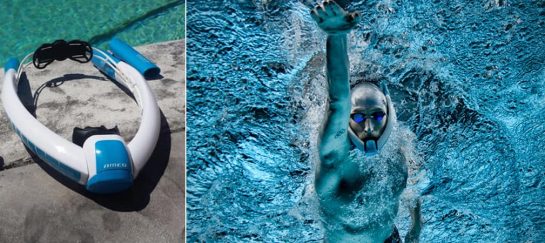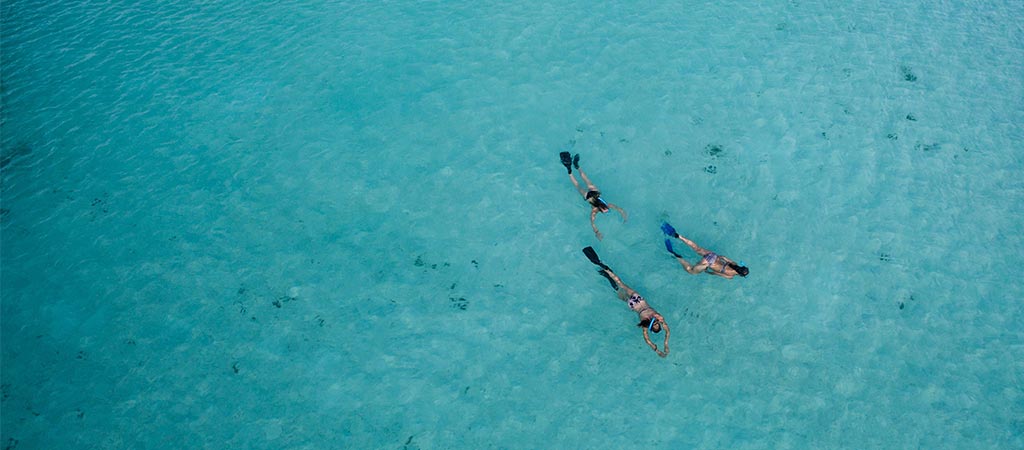
Guide to Snorkeling & Spearfishing
Intro
With summer well under way, it’s time to get back in the water and get into a new sport. Whether you’re interested in casual exploration of the sea life from beneath the surface or you’re looking to improve on your free diving skills as you spearfish, you’re going to want to make sure you’re buying the right equipment specific for snorkeling & spearfishing.
Snorkeling & Spearfishing: The Difference
Let’s start by differentiating….Snorkeling is a great sport for those who want to start exploring the underwater world but don’t have a whole lot of experience in the water. It has a low investment in comparison to other watersports and little skill is required to begin. With a basic comfort around water and some swimming abilities you will be set to jump in. In contrast, spearfishing is more of a hobby sport for experienced freedivers than a casual sport such as snorkeling. Unlike with snorkeling where your equipment consists only of a mask, snorkel, fins and a wetsuit, spearfishing requires more investment in additional gear (weight belts, booties, gloves, gun, and spear).
In this guide, we will explain the differences, side by side, between the gear required for snorkeling & spearfishing as well as list all the extras required if you plan to take up spearfishing and what you’ll need to know before you take the plunge.
Equipment
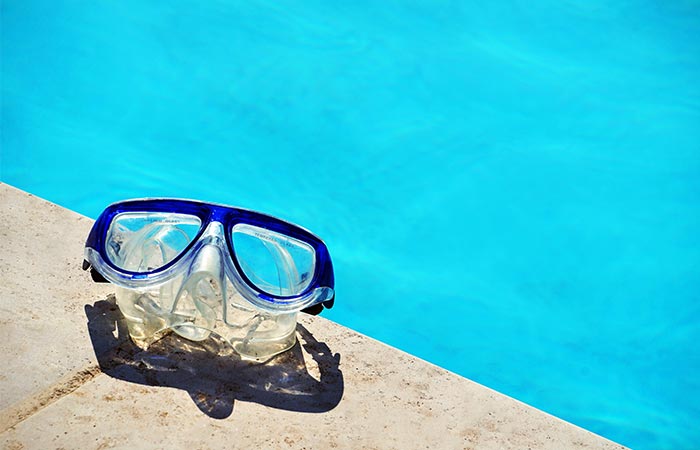
Mask
Although snorkeling & spearfishing masks differ quite a bit, when shopping for both activities you’ll want to begin your search by keeping in mind the importance of fit, comfort and quality of materials.
- Choose silicone over plastic to ensure a better seal. Silicone is longer lasting, durable, and more flexible
- Commonly made in clear or black (better for spearfishing as it keeps out more light)
Lenses
- Look for lenses with a high quality impact resistant glass
- # of lenses affect fit, peripheral vision and amount of air volume inside the mask
- Buy tempered glass lenses (lesson the risk of shattering or cracking; these lenses are also scratch resistant)
Air Volume
- High volume – more buoyancy
- Low volume – less trouble sealing, easier to purge water from the mask
Straps
- You can replace the standard silicone mask straps with Neoprene foam straps to increase comfort
Snorkeling Masks
With a snorkeling mask, you’ll typically have more options of lenses than you would with a spearfishing mask since low air volume is not as important with snorkeling.
Snorkeling Mask Lenses:
- Classic – One lens, nose inside
- One Lens – Less room for nose bridge
- Split/Two Lens – Lover air volume (less space for air in the mask)
- Three Lens – The addition of a side window, allows more light in, increases mask volume
- Frameless – Single lens attached directly to the silicon skirt. Lightweight, flexible and low volume
For full details on the parts of a snorkel mask check here: The anatomy of a snorkel mask
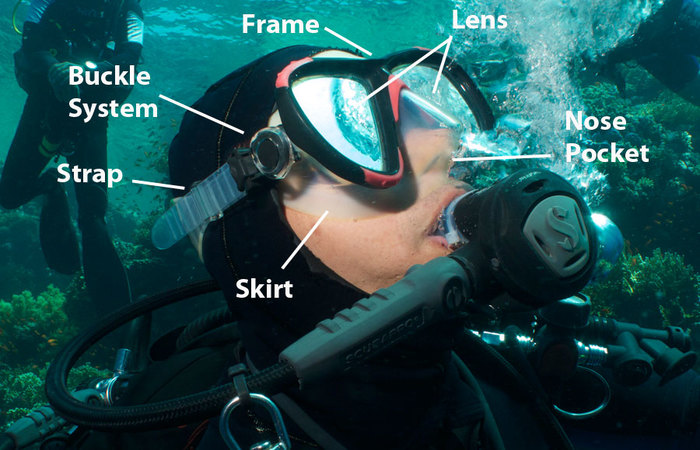
Spearfishing Masks
Since you’re going to be diving in deeper with this sport, a mask that makes the process of equalizing easier the further you go below the surface, will be one of your main considerations. Since your lungs will be acting as your air tanks when you’re under water, there is less available air, compared to a scuba tank for example, and therefore mask equalization will be considerably less.
Buying a mask with low air volume will make equalization that much easier as you’ll be exhaling less air into the mask. Spearfishing masks are designed to be closer to your face which lends itself to a wider area of vision.
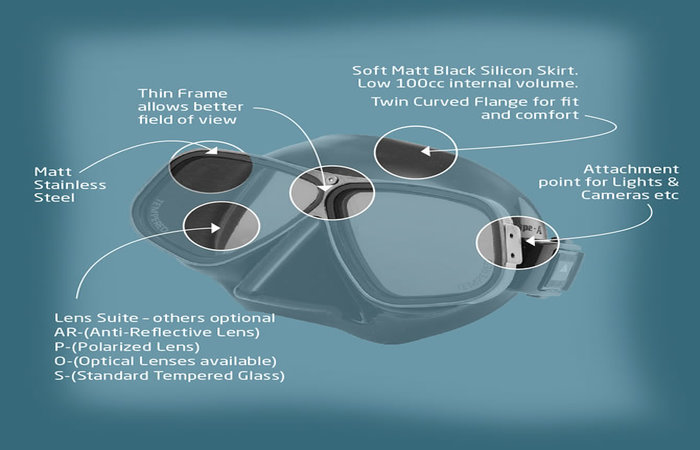
Remember:
- The lower volume the mask contains the better it is. There will be less trouble sealing and easier to purge water from.
- If you wear glasses, you may want to look into purchasing a mask with an optical lens. For a more detailed look to find out which lens you need on your prescription masks for snorkeling & spearfishing check here.
- Looking to take pictures under the water? There are a number of masks that have built in cameras.
- In the end, comfort and fit are the most important factors when selecting a mask. Check out this video to watch a tutorial on the proper fit.
- Look for a flexible mask skirt to ensure a comfortable fit and a mask with an enclosed nose piece to prevent mask squeeze.
Snorkels
When selecting a snorkel for snorkeling & spearfishing, just as in a mask, choosing silicone over a plastic will guarantee that it is more resistance to elements and will stand up against U.V radiation and chlorine. With silicone, exposure to air will cause a yellow tinge over time however this is only aesthetic and will not affect the performance of the snorkel. Keep in mind that simplicity is key to durability, the more bells and whistles the snorkel has doesn’t necessarily mean it’s better.
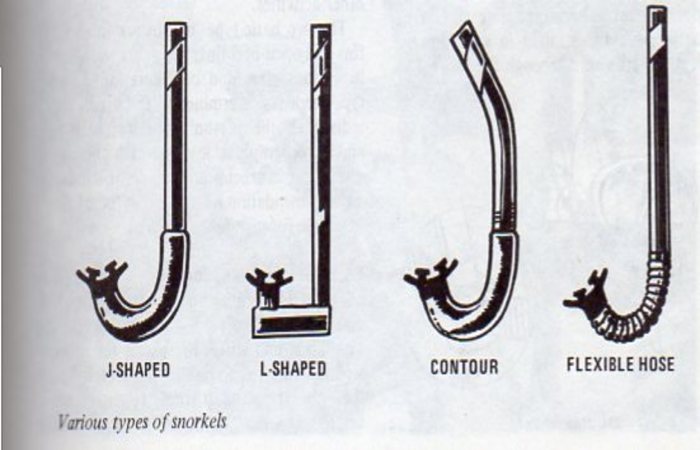
Purge Valve
- Not proven to be very effective therefore it’s best to go with a simple tube and no purge valve. Many people complain that the only thing a purge valve is good for is collecting sand and becoming clogged.
Tube Bore
- The bore or inner diameter is extremely important. If it’s too small, air passage will be impeded; too large and you’ll have difficulties blowing out water.
- Dry snorkels are great for allowing less water in the tube but are often top heavy and will lead to restricted air flow.
Mouth Piece
- Look for a mouth piece that isn’t too close or too far away from the tube so it will fit comfortably in your mouth.
- A scuba style shaped mouth piece may be better suited for snorkeling however isn’t ideal for freediving.
Snorkels For Snorkeling
Look for a snorkel with a medium length tube so that it will be able to keep elevated and stay out of the water. There are dry, semi dry and traditional dry snorkels; preference and comfort will come into play on your selection.
A snorkel that has a flexible neck will make clearing water out more easy. You may also want to buy a snorkel with a purge valve and splash guard for those windy days where water may get into the top of the snorkel. As previously mentioned, some find the purge valve ineffective therefore if the snorkel comes with it then great but you may not want to be pulling more money from your wallet specifically for a snorkel with a specialized purge valve.
If you’re looking to buy only one piece of equipment you may want to consider purchasing a face mask which incorporates the mask & snorkel in one unit.
Best Tribord & Face Masks for Snorkeling
- Tribord Easy Breath Mask
- Seaview 180 degree Snorkel Mask (GoPro Compatible)
- Octobermoon Snorkel Mask
Hot Item:
Are you wanting to go deeper in your underwater adventures but don’t have the scuba gear or experience and aren’t able to hold your breath while freediving? Check out the Scorkl!
Snorkels For Spearfishing
Select a freediving snorkel that is contoured yet rigid, and with a mouthpiece that has a comfortable fit. A tube with an attached float on the top is good to help avoid loosing it on the surface and a colored tip is a safe bet to ensure you will be visible in case of emergency.
Great Overall Snorkels For Snorkeling:
Great Overall Snorkel For Spearfishing:
The Omer Zoom Snorkle was specifically designed for freediving and spearfishing. Its ergonomic design with soft silicone mouthpiece and J-tube shape makes it a great overall snorkel for spearfishing.
Fins
With fin sets, comfort is the number one key. If they’re not comfortable, it doesn’t matter how functional they are if they’re just going to hurt your feet.
Snorkeling Fins
>A fin that is flexible yet stiff around the foot is what you want to look for. If swimming in warm water you can go with a full heel fin and for cold water an open heel fin with booties will be more suited.
* Select a shorter fin if you plan to stick more to the surface.
Spearfishing Fins
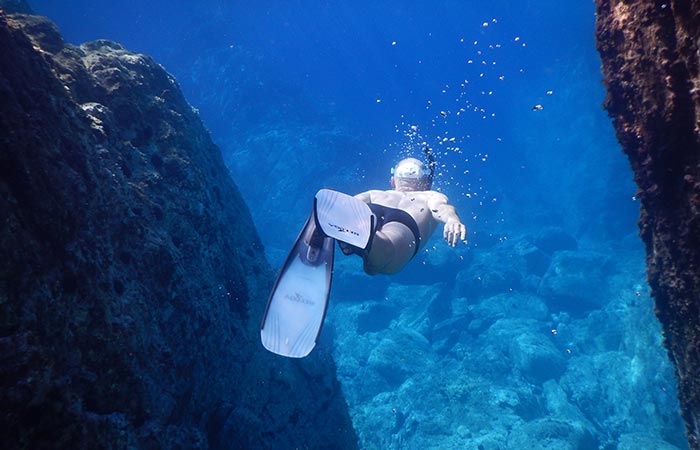
The main difference between a spearfishing fin and one for snorkeling is the length. Having a longer fin for freediving will give you more thrust without all the effort and help to maximize propulsion.
Bi-fins and Mono-fins are both used amongst free divers. Bi-fins are a single foot fin with an extremely long blade; they are made from fiberglass and carbon film, just as Mono-fins are.
Learn the Bi-fin technique
Mono-fins are a single fin that fits over both feet. They’re excellent for propulsion however the only downside is that they are less maneuverable. The technique required for Mono-fins is a bit difficult and will take time to learn.
Video : Mon-fin technique
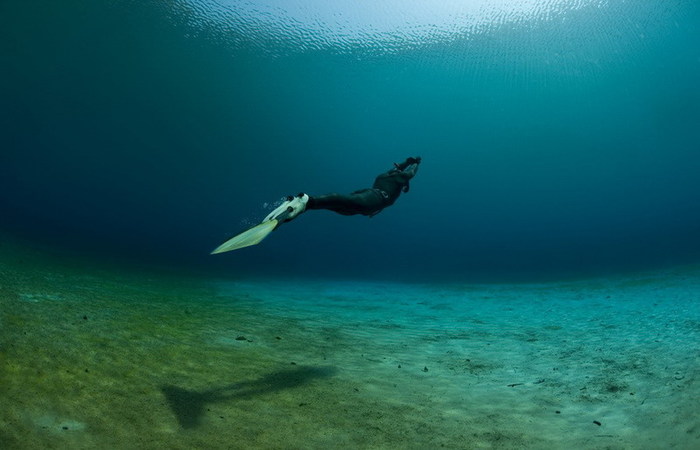
Wetsuit
If you’re swimming in warm water, you may only need some sun protection to cover up however in colder water, a wetsuit is essential.
Snorkeling Wetsuit
Select a suit with some buoyancy if you plan to stick more to the surface. A short sleeved neoprene top may do you just fine in warmer water but for colder temperatures, consider buying a shorty or full length wetsuit. A shorty will be more suitable for warmer water and will allow for more flexible movement.
* A thinker suit (7mm) is best for use in cold water; in contrast, a suit of 2-3mm will be good for warm water snorkeling.
Spearfishing Wetsuit
Wetsuits for freediving normally consist of 2 parts; waist high pants and a top with a hood. Often called an ‘open call’ wetsuit, their composition is of a neoprene interior and nylon on the exterior which gives an extra bit of durability. The hood will act as protection and it will help keep you warm.
It’s best to purchase a suit that is the thinnest possible, to allow for flexible movement, while still providing warmth. Freedivers prefer close fitting suits without a zipper to minimize water circulating.
Equipment Specific to Spearfishing
Weight belts
This is a piece of equipment that you’ll need if you want to counteract buoyancy. If fishing in shallow water, between 20-30 feet, a weight belt isn’t so necessary however in deeper waters it becomes more of an essential.
Weight belts for spearfishing are made out of a rubber material so that they can stay securely on your hips when the water pressure is acting to compact your suit during your decent. To facilitate deep breathing, the weight belt is worn on the hips.
Spearfishers and other free divers prefer to use small hydrodynamic weights to minimize water resistance and for safety, they look for a quick release option from the belt so that they can drop the weight in an emergency if required.
Shop for Weight Belts & Weights
Booties
Hard rubber sole boots have been commented on by avid spearfishers as being the best. Many have recommend the Quicksilver brand for carrying the best high quality hard rubber sole boots.
Gloves
Mainly for protection from underwater threats, gloves act as a barrier to coral, spikes from fish fins and other underwater dangers. Gloves are much left to the preference of the person wearing them; check out some of the best available, here.
If you’re new to spearfishing, it’s best to start off with a speargun that is roughly 75cm in length so that you can get comfortable with how it functions and maneuvers in the water. The longer the speargun the greater the range however when you’re starting out, keep in mind that technique and skill should be your focus rather than securing the biggest catch.
Spearguns
A speargun is made up of a handle, trigger, barrel, bands and spear, and sometimes can include a reel. It’s constructed from a combination of aluminum, which is quite inexpensive, and carbon which adds a strength to the speargun while keeping it lightweight. The 6mm diameter bands are mounted on the barrel and are what propel the spear.
For more information on everything to know about spearfishing, including the best spearguns on the market today, check back in the next few weeks where we’ll dive into the topic.
Final Comparison: Snorkeling & Spearfishing
After comparing the equipment required for each of these two watersports, i’m sure you now understand a bit more about why selecting the proper gear for the sport you plan on doing is essential. Although snorkeling & spearfishing gear lists include both a mask, fins, and a wetsuit, you’re going to want to make sure you have bought these three items specifically for either snorkeling or spearfishing to ensure a positive experience. Remember that if you’re looking at taking up spearfishing make sure you’re already an experienced and confident diver and be sure to equip yourself with the additional gear required. The basic additional equipment you’ll want to invest in for spearfishing will be weight belts, booties, gloves, a gun and a spear.
Lastly, no matter what watersport you’re doing, remember to put safety first and educate yourself on how to properly and safely use the gear equipment you have. Select the right gear for the activity, keep safety in mind and we are sure you’ll have a great time in the water!
Daily Newsletter
Subscribe to Jebiga for a dose of the best in gear, design, rides, tech and adventure.

